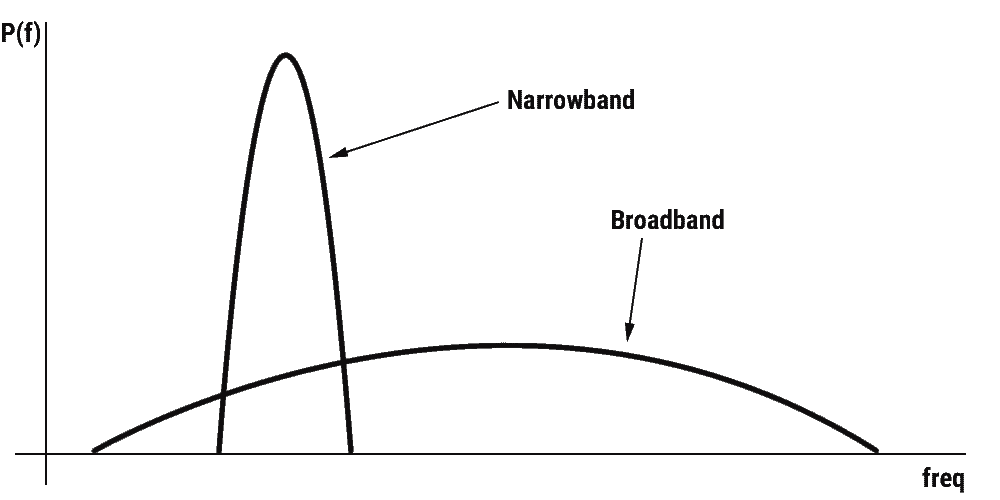When referenced together, the use of the terms narrow-band and broadband, as well as their meaning, depend on the context in which they are being applied.
Most people would already be familiar with broadband as a reference to Internet access that gives them adequate speed and bandwidth to comfortably execute applications over the Internet, stream movies without continually buffering, or upload and download very large files in a few seconds.
Broadband and Narrowband in Different Contexts
In this context, broadband equates to the wide bandwidth and high speed transmission of data. The Federal Communications Commission’s (FCC) Household Broadband Guide, gives a rough indication of expected broadband speeds, based on the number of users or devices connected, and the class of usage.
In the guide, usage is classified as light, moderate, and high, depending on the bandwidth demands imposed by functions such as email and browsing, High Definition (HD) video streaming, or high demand applications.
It then offers a range of broadband speeds it considers are appropriate to cover the number of users (or devices) and the class of use. We generally consider the greater the speed and broader the bandwidth offered by an Internet service provider, the better the connection.

In this context, narrow-band would therefore infer Internet access that offers a slow, limited bandwidth connection, such as that provided with the old dial-up connections. One other difference between narrow-band and broadband in this context, is that broadband is an always on, always available service.
The phrase “more is better” would seem to fit nicely here. But there are also situations when the opposite is the case, and is in actuality, desirable. In fact, the terms narrow-band and broadband have been in use in telecommunications, well before the Internet came into being.
In this context, broadband refers to a wide band of electromagnetic frequencies.
With regard to the advancements in technology, and especially the move from analog to digital, if we take a look at two-way radios, narrow-band is preferable, since it allows more channels to fit into an allocated bandwidth range, or in the case of existing systems, to provide a better quality of service.
The FCC has authorized 22 channels in the 462 MHz and 467 MHz range for use by the Family Radio Service (FRS), a private two-way, short-distance voice and data communications service. The range is shared with the General Mobile Radio Service (GMRS), a land-mobile service, also used for short-distance, two-way communication.
Prior to 2013, channel bandwidth had been set at 25kHz, and going further back, it had been as wide as 50kHz. In 2013, a mandate by the FCC was introduced requiring all licensees to migrate to a 12.5kHz channel bandwidth.
Even though there has been a steady narrowing of the channel bandwidth, not surprisingly, the quality of the service has improved, as more efficient modulation methods are being developed and implemented. Some manufacturers have even come up with 6.25 kHz narrow-band radios that function just as well as the original wideband radios.
Among others, the benefits of using a narrower channel, are better channel separation, reduced transmit power requirements of two-way devices, and overall lower noise across the bandwidth, which in turn has provided better sensitivity and range.
Another case where narrow-band is desirable over broadband, is with Internet of Things (IoT) devices. IoT devices connect with other devices over communications networks, including the Internet, in order to collect and/or share data.
Narrow-band Internet of things (NB-IoT) is the standards-based low power wide area network (LPWAN) most commonly used by IoT technology developers.
Among other things, NB-IoT significantly improves system capacity and spectrum efficiency, limiting the bandwidth to a single narrow-band of 200kHz and subsequently allowing for high connection density.
Advantages and Disadvantages of Narrowband and Broadband
Narrow-band systems are inherently less complex than broadband systems.
Broadband systems have more complex filters (filters are circuits or devices that are used to remove unwanted noise and to provide channel separation).
Broadband circuits require more filters in order to achieve a higher Signal to Interference plus Noise Ratio (SINR).
The probability of overlap with interfering signals is relatively low in narrow-band signals. As the bandwidth increases, so does the probability of interference.
In narrow-band systems, the transmitted energy is concentrated on a smaller portion of the frequency spectrum. As a result, channel to channel isolation is much better.
Broadband signal energy is distributed across a wider portion of the spectrum, making the signal weaker the wider it gets, hence requiring a higher Signal to Noise ratio (SNR). This makes broadband transmission and reception more difficult.
Power requirements for narrow-band are much lower. This makes them ideal for transmission over short distances.
Broadband systems offer much higher data rate transmissions and faster communication, whereas narrow-band systems are slower and offer far lower data rate transmissions.
Narrow-band signals usually have a far greater range of reception, as narrower filters can be used and therefore cancel out unwanted wideband noise. The transmitted energy also concentrates on a smaller portion of the spectrum.

